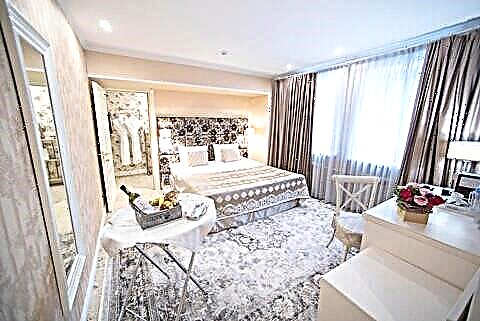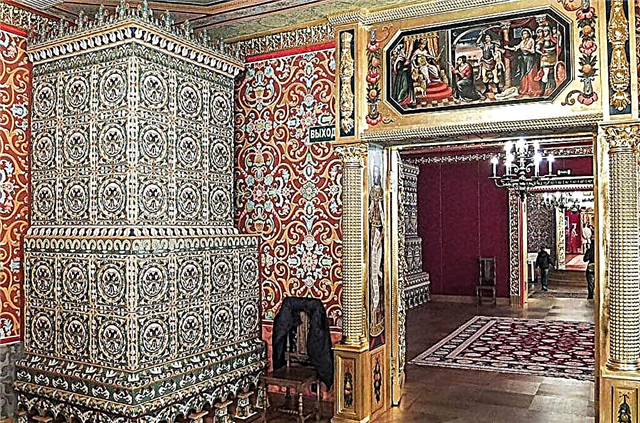The ancient village near Moscow Kolomenskoye is located in the Southern Administrative District of the capital of Russia on the banks of the Moskva River. Since ancient times, this territory was considered a princely, and then a royal patrimony. The first buildings appeared here at the beginning of the XIV century. The best time for Kolomenskoye came during the reign of the second tsar from the Romanov dynasty - Alexei Mikhailovich. The sovereign's favorite place inspired him to build a magnificent palace, which later became a masterpiece of Russian wooden architecture of the 17th century.
Modern Kolomenskoye is a museum in a conservation area. Surrounded by birches and apple trees, the original residence of the king has been restored. Lovers of history, as well as tourists, are impressed by the atmosphere of the life of the tsar and his family. Visitors to the estate can study the details of the decoration of the sovereign chambers.
Construction history

In 1667, Aleksey Mikhailovich personally laid the foundation for the Kolomna Palace. Despite his high position, the king did not shy away from doing craft. For him, the beginning of the construction of a personal choir was a personal outlet and a kind of political move. The erection of the chambers demonstrated to foreign ambassadors the power and steadfastness of the Russian state. The second half of the 17th century in Russia was marked by important events. Since 1654, a fierce war was waged with the neighboring Rzeczpospolita. Russian troops conducted a series of triumphant campaigns against the Poles, as a result of which a ceasefire was signed for 13 years.
Kolomna Palace was built by an artel of carpenters. The craftsmen erected the most beautiful royal chambers in the best traditions of Russian architecture. The wooden manor consisted of many asymmetrical chambers, connected by hallways and passages. Hip roofs of unusual shapes were decorated with fine carvings, and above them were weather vane and double-headed eagles. All finishing works were completed in 1673. The living area of the premises was over 7,000 square meters. The ceilings were over 20 meters high. There were 270 halls in the palace. The palace was divided into male and female halves. The completion of the construction was marked by solemn feasts and festivities.
For Aleksey Mikhailovich, the Kolomenskaya estate had a high status. He often received foreign ambassadors and important guests here. As befits a decent family man and father, the tsar assigned separate chambers to his children, as well as to his second wife Natalya Naryshkina. Subsequently, the heirs of Alexei Mikhailovich were engaged in the reconstruction of the Kolomna Palace. During the reign of Fyodor Alekseevich, dilapidated buildings were rebuilt, and under Peter the Great the foundation of the building was restored. After the transfer of the capital of Russia to St. Petersburg, the estate gradually collapsed and fell into disrepair.
Empress Catherine II planned to restore the palace, but the wooden structures were badly rotten and could no longer be repaired. The Empress ordered to dismantle the estate. At the same time, she ordered to pre-measure each element of the structure, draw up a plan of the palace and describe all material values. It was this decision that allowed her contemporaries to enjoy the Kolomna Palace with their own eyes in all its original beauty.
In 2010, with the support of the Moscow City Government, the original palace was recreated according to the preserved drawings. More than 200 people were involved in the construction of a unique piece of architectural art. For reliability, wooden structures were replaced with reinforced concrete elements, lined with wood. This is the only deviation from the original structure.
Exposition and interior decoration

The sovereign valued objects of art and luxury. The restored palace has an exposition with the closest possible interior decoration of the 17th century. Entering the chambers of the royal estate, guests are delighted with the rich furnishings and ancient household items. All the walls of the palace are painted with a popular type of decor of that era - floral ornaments. The herbal letter depicts stylized flowers, leaves, bunches of grapes. Windows and doors are framed with patterned wooden platbands. Stained glass mica glass shimmers with bright colors. Persian carpets are spread on the floor and benches.
Painted ceilings and tapestries tell biblical and mythological stories. The elegance of the decor gives the premises of the palace a special beauty. The royal estate contains exquisite carved furniture, according to the inventory of the 18th century. Each chair, armchair, table, wardrobe is a unique piece of art. Lanterns, lamps, gilded chandeliers bring pomp and elegance to the chambers. The guests of the museum are shown royal household items: dishes, books, old maps, knightly armor and halberds, watches, paintings, icons and much more. At the corners of all chambers there are multicolored tiled stoves.
Mansions of the tsar and princes

The main entrance to the palace is a red porch decorated with rich carvings. According to the palace rule, only the king had the right to ride a horse to the wooden steps. Foreign ambassadors and noble boyars had to walk to the front door, where they were greeted by a guard of honor. Through a double door decorated with gilding and state symbols, visitors to the palace enter the royal chambers.
The most spacious and elegant room is the refectory. Overseas guests were received here, holidays were celebrated. The king sat on the throne, and the guests on the benches. A wide and long table was located along one of the walls. The ceiling of the refectory features a delightful painting of the zodiac signs revolving around the sun and moon. The Duma Chamber served as a room for negotiations with ambassadors and boyars. Noble dignitaries gathered here to discuss state affairs, present letters and salaries. In the corner of the room there is a royal chair, above which there are iconostases with images of the faces of saints.

The throne chamber, where the solemn ceremonies took place, demonstrates the greatness and power of the Russian state at that time. The walls, ceiling and window openings are replete with multicolored paintings. The royal throne rises on the pedestal, made of precious wood and decorated with overlaid gold, silver and ivory. Alexey Mikhailovich tried to amuse and surprise his guests. Near his chair are delightful movable sculptures in the form of lions. When the mysterious button is pressed, they emit growls, sparkle eyes and twist their heads.

The king spent most of the day in his office. In this secluded place, hiding from prying eyes, the sovereign worked with documents, wrote decrees, read books. The room is furnished with a table, carved chairs and a bookcase. Behind the wall of the study is the royal bedchamber. The soap shop was an integral traditional attribute of the old Russian dwelling. There are four baths in the Kolomna Palace. Massive wooden fonts were intended for bathing the royal family.

The mansions of the sons of Alexei Mikhailovich deserve special attention. Fyodor's large room epitomizes the colorful Polish pomp of the interior. The walls are framed with special leather wallpaper. Bright chairs, a massive table, a wardrobe with an abundance of books characterize the sophistication and education of the owner. The mansions of Peter are distinguished by their severity of the German-Dutch style. The room is decorated without any frills. Oak table, grandfather clock, carved chairs. The environment encourages concentration in studies.
Opening hours and ticket prices
Those wishing to replenish their historical knowledge can visit the palace of Alexei Mikhailovich in Kolomenskoye from Tuesday to Sunday. To visit the royal chambers, it is recommended to purchase a complex ticket that allows you to visit all the premises of the palace, for 400 rubles. Additionally, you can purchase an excursion and a photography permit (100 rubles each). The palace is open from 10:00 to 18:00.
Where is it located and how to get there
The palace is located at the intersection of Kashirskoye Highway and Andropov Avenue. You can get to the estate by metro to Kashirskaya station, and then walk a little to the protected area. The outlines of the towers of the building are visible from a distance. There will be signs on the way, so it will not be difficult to get to the estate.











